|
|
FUGUE:
CHAPTER
IV
REMOVAL
OF THE ORGAN TO ST. PETER'S CHURCH, HARROGATE
For
a few years Mrs. Kennedy played the Schulze organ in its original
setting at Meanwood Towers for her own enjoyment and to the
delight of her guests and sometimes of villagers of Meanwood who
listened outside, but unfortunately she became unwell and was
advised to abandon playing on her favourite instrument. In
addition, the wooden structure in which the organ was housed began
to need repair and Edmund Schulze warned Mr. Kennedy that the
organ would certainly suffer from damp if allowed to remain in the
building. Also, although central heating was provided, it
had never been easy to maintain a reasonably constant temperature,
with the result that the organ was frequently out of tune.
Mr. Kennedy therefore felt obliged to part with the organ for its
preservation and offered it for sale.
The
organ was purchased by two maiden ladies, the Misses Carter,
daughters of Nicholas Carter of Spring Bank, Harrogate, one of the
foremost pioneers of the development of Harrogate as a Spa in the
early 19th century. The Carter family had taken a great
interest in the building of St. Peter's Church, Harrogate, and the
sisters lent their Schulze organ to the church which had
previously used a small instrument lent by Mr. Walker Joy, the
Leeds musical amateur. The organ was duly installed in the
south transept of the church under the supervision of Edmund
Schulze, in its original case and with its original pneumatic
lever action, on the understanding that the loan would become a
gift on the decease of the surviving donor.
The
organ was inaugurated on 16th August, 1877, with fully choral
services sung by the choir of Leeds Parish Church, Mr. R. S.
Burton, organist of that church presiding at the instrument, as
indeed he did on other important occasions. The anthems sung
were "The Wilderness" (S. S. Wesley), "If with all
your hearts" (Mendelssohn) and "Hallelujah Chorus"
(Beethoven). The "dulcet tones" of the organ were
greatly admired during the softer passages of these anthems,
whilst:
‘.
. . the strength and capacity of the instrument, amply sufficient
for a much larger edifice, were apparent enough as –
in
vibrations which seemed almost to shake a strong building –
it pealed forth language of triumphant exultation’
The
Yorkshire Post and Leeds Intelligencer, Leeds Mercury, 17th
August,
1877
The
organ was, in fact, too large for the church and, according to
Allbutt who once heard it in its second home, it did not sound as
well as at Meanwood, being rather suffocated. The acoustics
of St. Peter's Church are much less favourable to organ tone than
those of St. Bartholomew's Church, Armley.
The
vicar of St. Peter's, the Rev. L. E. W. Foote, was unwilling to
accept the organ as a loan to the church in spite of the clear
understanding that the loan would ultimately become a gift, and he
gave the Misses Carter the option of either making the instrument
a gift outright, or of removing the organ. The ladies, no
doubt to his surprise, took the latter course and had the organ
removed! When the vicar related this story to that authority
on Schulze, the Rev. J. H. Bum, he seemed to be rather sorry for
himself.
In
spite of all this unpleasantness, the Carter sisters were
determined that St. Peter's Church should have a Schulze
organ. Therefore the Misses Leonora, Arabella and Rebecca Anne
Carter ordered a small two-manual and pedal organ from J. F.
Schulze & Sons, with the following specification:
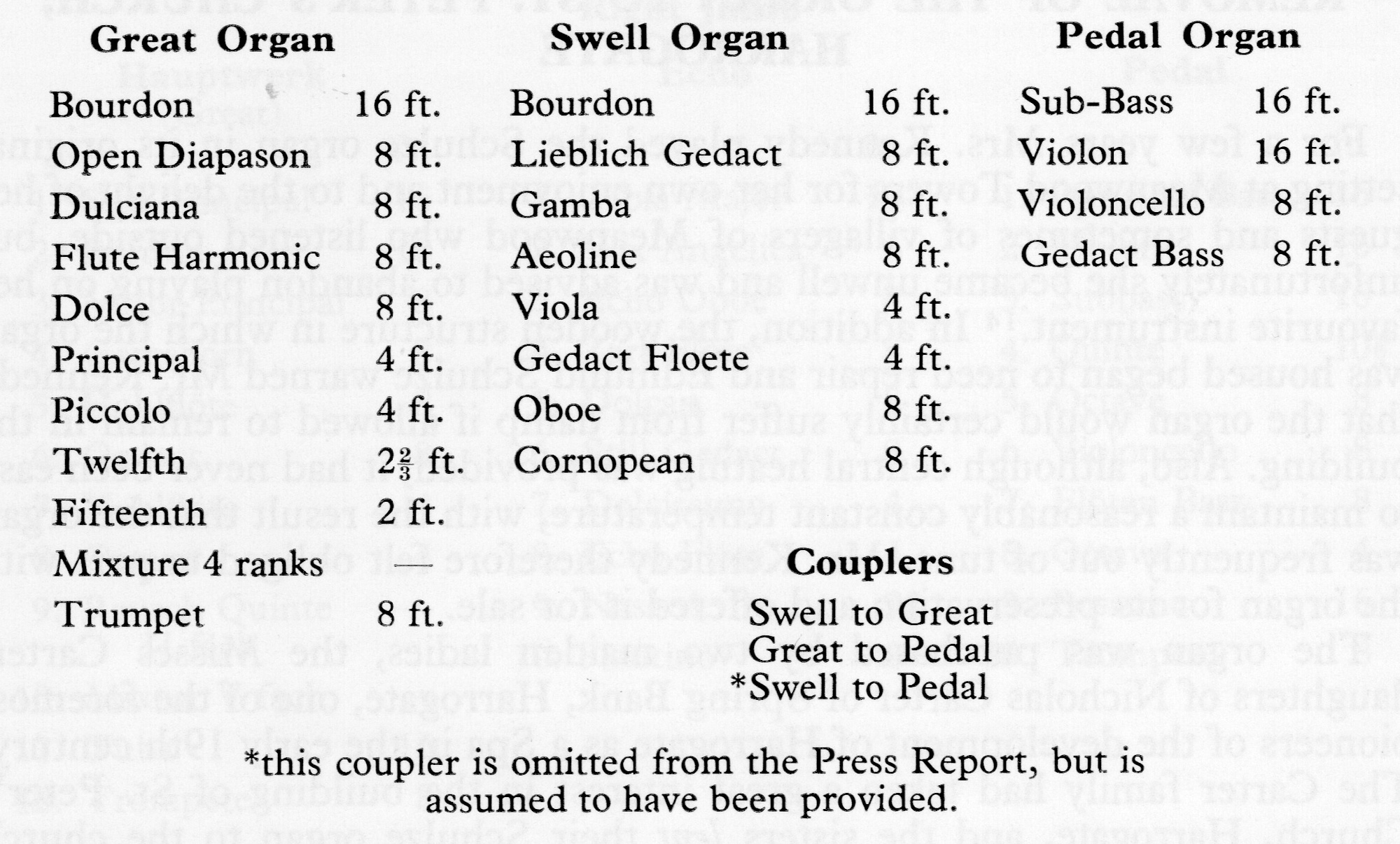
|
|
The
new organ was inaugurated on 28th June, 1879, at a special
service on the Vigil of St. Peter, when the church choir was
augmented by members of the Leeds Parish Church choir, Mr. R.
S. Burton again presiding at the organ. The Press Report of the
opening is interesting:
“Many
who have been accustomed to the grand tones of the old organ,
may regret its removal; but we confidently assert that the new
instrument, though smaller in structure, does not fall short of
it in sweetness, or in the full swell of its deep diapason tone
. . . The smaller organ . . . is in fact the last work upon
which Mr. Schulze bestowed his personal care and ability, prior
to his lamented death a few months ago.”
Actually
this organ was probably completed by Eduard Schulze after
Edmund's death. The spotted metal front pipes were
provided by Brindley & Foster of Sheffield, who erected the
organ after removing the four-manual Schulze instrument to
Armley.
|
In
1891, this second Schulze organ was rebuilt by Abbott & Smith
of Leeds when, in order to accommodate a new swell box, the
instrument was moved from the south side of the church to the
north aisle of the chancel, formerly the vestry, where it now
remains and a new vestry was built at the north-east angle of the
church. The whole of this work was carried out at the
expense of Messrs. Nicholas and Richard Carter, who were brothers
of the donors of the organ, then deceased. Further additions were
made to the organ by J. J. Binns of Bramley, Rushworth &
Dreaper of Liverpool and, in 1952, J. W. Walker & Sons of
Ruislip rebuilt the organ completely with a new four-manual
console, electro-pneumatic action and many new stops, but
retaining most of the Schulze pipes. The opening recital was
given by Dr. W. N. McKie of Westminster Abbey on 11th September,
1952.
Some
later work to sustain the quality of this organ was undertaken in
1986 when H.E. Prested of Durham cleaned and re-leathered the
organ, as well as adding 2 electronic feet pipes.
A renovation of the organ was completed in 2002 by Peter Wood and
Son, Harrogate. The dangerous cotton-covered wiring of the
1950s was replaced as part of this overhaul and a computerised
stop management system was
installed.
****************************************************************************************************************
CHAPTER
V
PRESENTATION
OF THE ORGAN TO
ST. BARTHOLOMEW’S CHURCH, ARMLEY, LEEDS
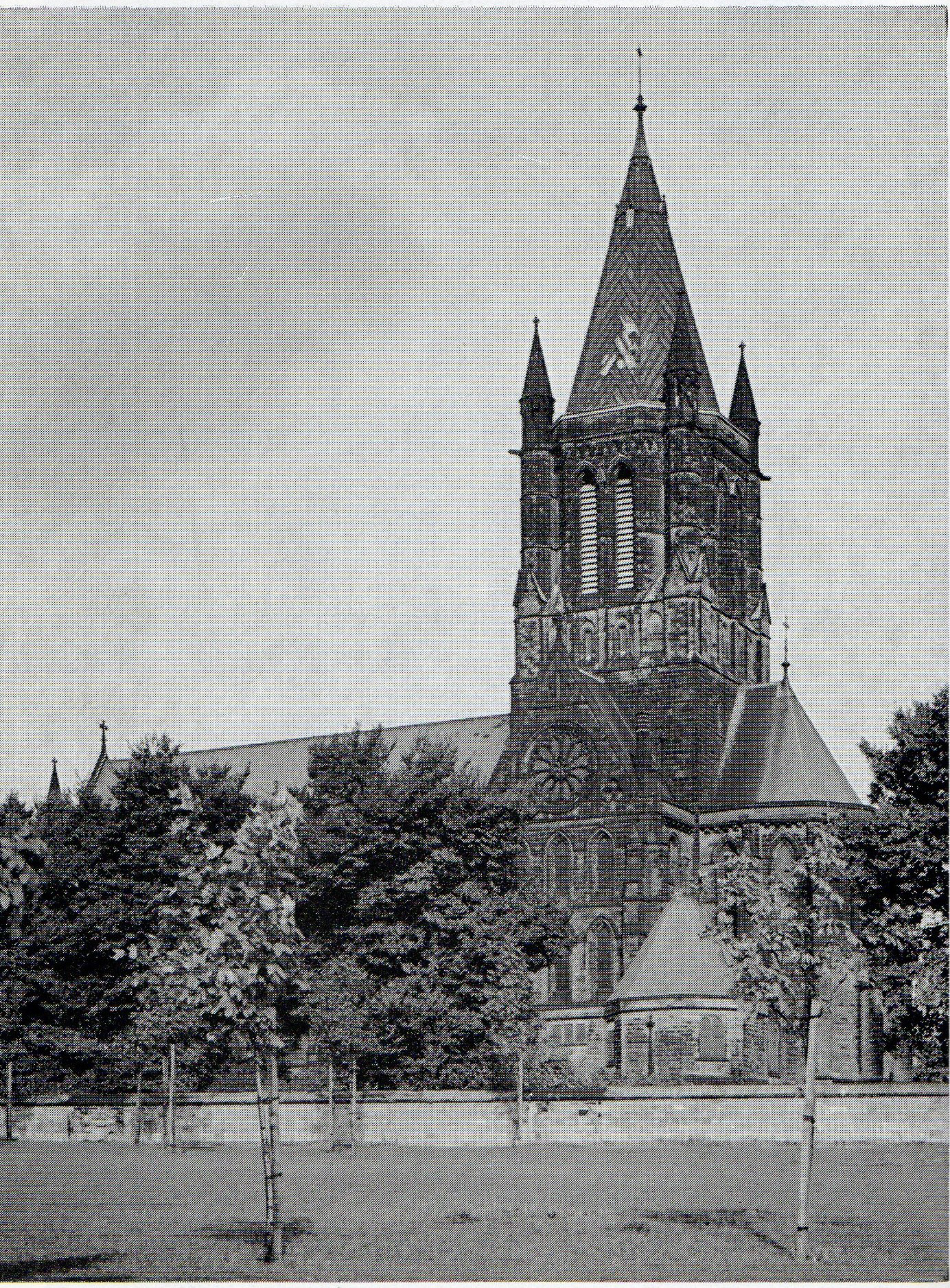 St.
Bartholomew’s Church from the SE (1975) showing the short
eastern apse and South Transept clustered round the Tower and
the Nave roof ridge to the left.
St.
Bartholomew’s Church from the SE (1975) showing the short
eastern apse and South Transept clustered round the Tower and
the Nave roof ridge to the left.
|
|
The
present Church of St. Bartholomew at Armley was built to
replace an older church, formerly a Chapel of Ease of Leeds
Parish Church, dating from 1630 and enlarged in 1737 and again
in 1834. Of modest architectural pretensions, this
building was demolished in 1909, the foundations alone now
remaining to the north of the new church.
The
new church, designed jointly in 1872 by Mr. H. Walker,
F.R.I.B.A. and Mr. J. Athron, both architects of Leeds, was
consecrated on 24th August, 1877, although still lacking the
tower, western turrets, porches and choir vestry. Built
in Early English Gothic style, the rather severe exterior is of
sandstone with a large nave, shallow transepts, each of a
single bay, and a very short apsidal eastern arm, all clinging
closely to the massive central tower with octagonal spire and
four spirelet pinnacles.
The
whole grouping, according to Pevsner, is reminiscent of the
Rhineland churches and, standing on a magnificent site on
Armley hill, the church can be seen from afar. Internally of
warm-toned Ancaster limestone, the lofty six-bayed nave (98½ft.
long, 30ft. wide and 73ft. in height to the roof ridge) is
separated by rather slender clustered shafts of Greenmoor stone
from narrow vaulted aisles. Above a clerestory of large
coupled lancets, nave and transepts are spanned by open timber
roofs with tie-beams above a coved portion.
The
choir occupies the spacious crossing between massive piers with
clustered shafts, designed to give minimal obstruction to the
passage of light and sound, and carrying the tower on lofty
arches, the vault rising to 59½ feet from floor
level. The short eastern apse is also vaulted and alone
forms the sanctuary. Thus, although the sound of the
organ is projected from the north transept at right angles to
the east/west axis of the church, because of the very shallow
transepts, the unusually short eastern arm and the spacious
crossing, the acoustics are ideal for the instrument as heard
from the nave.
|
Henry
William Eyres, donor of the organ
The
Eyres family were benefactors both of the old Armley Church and of
the new St. Bartholomew's. William Eyres (1759-1837)
established the firm of William Eyres & Sons as cloth
manufacturers at Armley. Of his twelve children, William
(1789-1851) and Samuel (1793-1868) carried on the business at
Winker Green Mill, later known as "Eyres Mill," becoming
pioneers in the manufacture of worsted by power at Armley.
The firm's mill still exists today (see below, converted
to flats; the boatyard has gone!) and several streets in its
vicinity carry the name of Eyres.
Samuel amassed a great
fortune and had one daughter, Anne Elizabeth, who by her second
marriage to the Rev. Samuel Kettlewell, Vicar of St. Mark's
Church, Leeds, had three children, the eldest being Henry William
Kettlewell, born at his parents' home Armley Grange, on 20th July,
1857, who inherited much of the family fortune and adopted the
surname Eyres by Royal Licence in 1878.
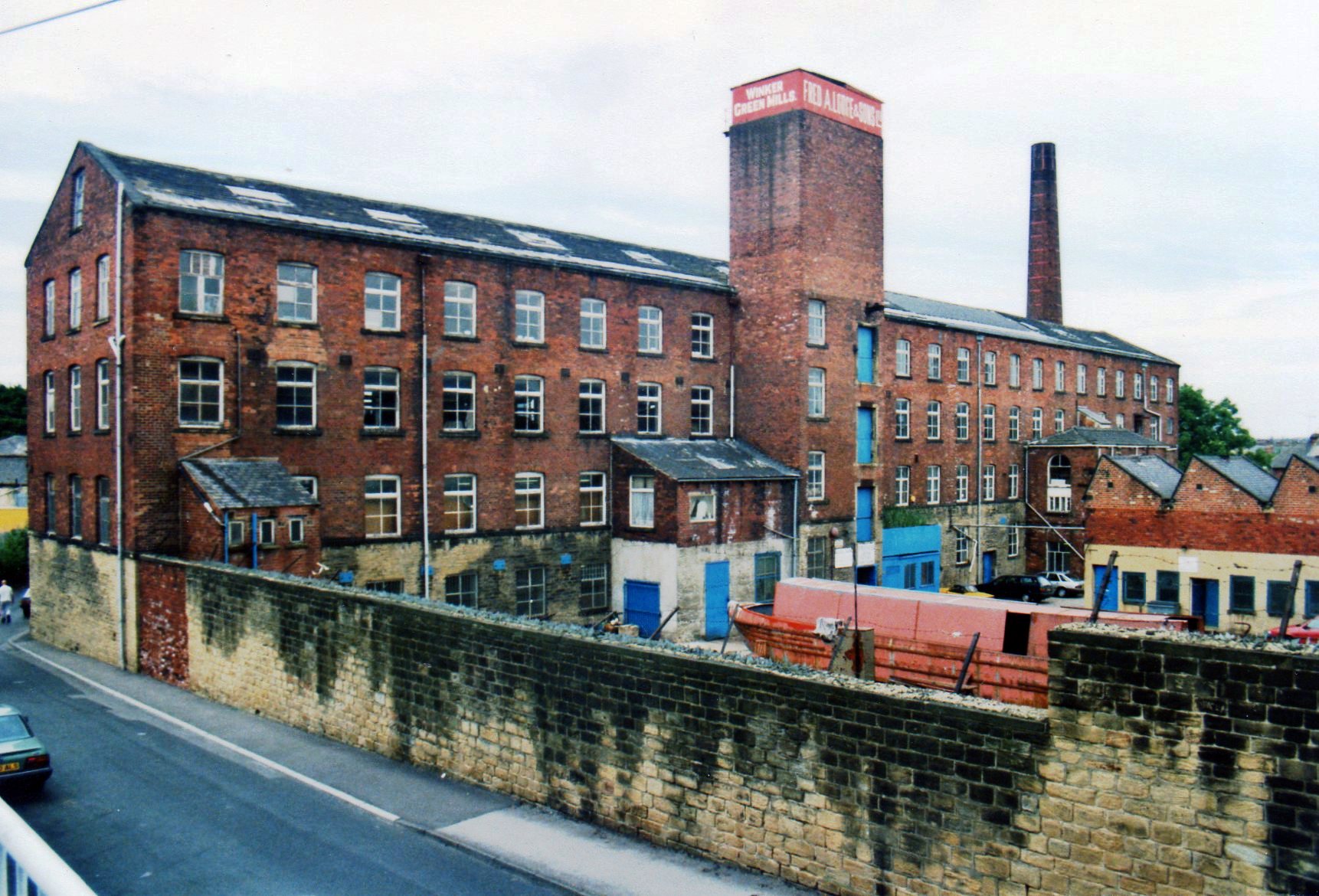
|
|
Educated
at Harrow School and at Trinity College, Cambridge, from which
he graduated as B,A. and LL.B., Henry William Eyres who resided
chiefly at 41 Upper Grosvenor Street, London, always had a
great affection for the parish of Armley, his birthplace, and
took a great interest in its welfare because of the
long-standing family connection with Armley. Wishing to
make a worthy gift to the new St. Bartholomew's Church, Mr.
Eyres purchased the Schulze organ from the Misses Carter of
Harrogate.
Mr. R. S. Burton being his musical
adviser, and presented it to the church as a thank-offering for
his forthcoming marriage. He married Caroline Isabel,
daughter of Edward Sharp, at Holy Trinity Church, Bingley, on
20th October, 1880.
Two additional stops were ordered from
J. F. Schulze & Sons to augment the Pedal Organ, namely the
Sub Bass 32ft. and the open Metal Principal 1 Bass 16ft., as
named on the original stop knobs, the latter stop to stand in
the new case.
|
The
Organ Gallery and Case
There
appears to be no record of the original appearance of the organ,
either at Meanwood or at Harrogate - it is not mentioned by
Allbutt in his memoirs and the Rev. J. H. Burn, writing in 1922,
had unfortunately no clear recollection of it. The case
cannot have been of particular merit, or was considered to be
inadequate for its prominent new position, and would almost
certainly have possessed only a non-speaking pipe front, as
referred to early in the correspondence from Schulze to
Kennedy.
The
magnificent American walnut case and the stone gallery on which it
stands have generally been attributed to Walker and Athron, joint
architects of the church. However J. J. Binns of Bramley,
near Leeds, who rebuilt the organ, stated in his "Directory
of Organs," published in 1910, "Case designed by Mr.
Thorpe," and this name has been given to the author by two
organ-builders in the Leeds area. There was certainly an
architect Henry William Thorp (sic) practising at 22 Park Row,
Leeds, in 1878 but whether or not he was the Thorpe mentioned by
Binns is unknown. It is possible that Binns was confusing
the present case of 1879 with the original
case of the organ when at Meanwood
Towers, and probably also at Harrogate. This was evidently
made in England to Kennedy's requirements since, in a letter of
26th January, 1869, from Schulze, the craftsmen working on the
case are instructed to leave an opening 5 feet wide for the
keyboards.
The
Press Report of the opening of the organ at Armley states:
“The
organ case will, of course, be entirely new, though this was
unfortunately not completed in time for the opening ceremony.
The
architect’s design (author’s
italics), and the portion of it already fixed – with the
elaborate traceried gallery front – will give
a very
good idea of the character of the work.”
Examination
of the documents relating to the organ, now in the care of the
Leeds City Archives Department, revealed three designs for the
organ case.
1. "First
sketch for Organ" (no
illustration) is in very poor
condition and is neither signed nor dated, but shows an elegant
Gothic case supported on an apparently wooden
screen and gallery below the northern arch of
the crossing and surmounted by winged angels. The central
figure reaches only to the level of the capitals of the piers of
the crossing, i.e. much lower than the present case. There
is only a single, central tower of three large pipes, flanked by
two tiers of flats, each of seven small pipes and, beyond these on
each side, are flats of six pipes with Gothic tracery as pipe
shades. Further overhanging sections have been added in
pencil. From the surrounding masonry and by comparison with the
second design, it is clear that the "First sketch"
refers to the Armley church and that both designs are from the
same hand.
2.
The second design,
see below, drawn
in ink on tracing paper with a sepia wash, by Walker and Athron,
28th September,
1878.
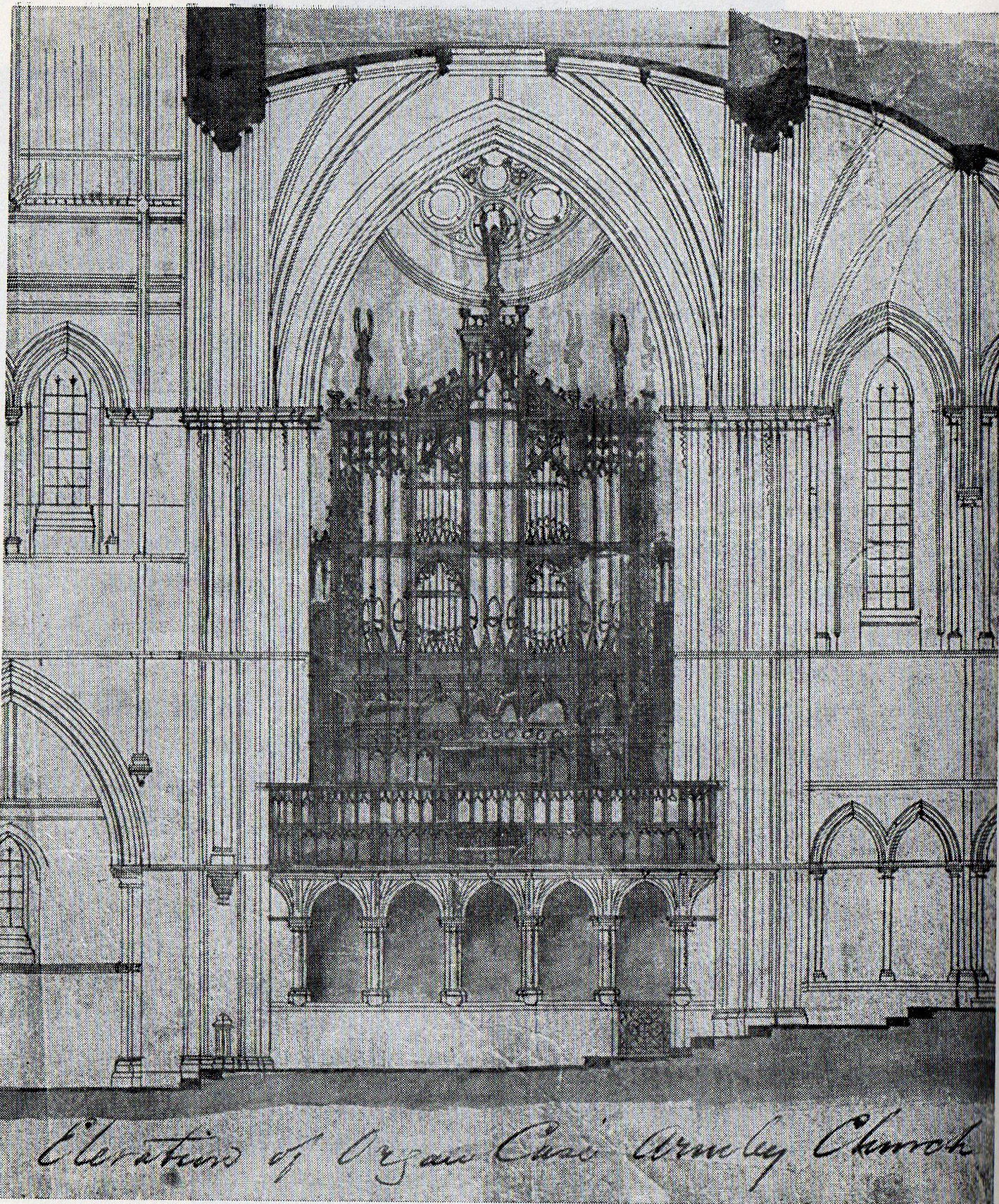
|
This
drawing includes on the left one-and-a-half bays of the nave
and, on the right, the apsidal sanctuary, with the architects'
names. The organ case is shown in relation to the arch of
the crossing, standing on a stone gallery which differs from
that of the third design, and from the gallery actually built,
in that the stilted bases of the supporting pillars are joined
by a continuous low wall, except where broken in the
easternmost bay by a wrought iron gate. The organ case
rises above a panelled screen with an advanced portion to
accommodate the console, as at present, but is lower than the
present case, revealing part of the circular window in the
transept gable. There are three towers each of three
pipes, the central tower being very prominent, whilst metal
bands cross the flats and enclose the large pipes of the
towers. There is evidence of alteration in the positions
of the angels above the towers in this drawing, but no evidence
of the two angels below the side towers as later executed. This
drawing is accompanied by a section from north to south through
the transept, similarly signed and dated, showing the organ at
the level of the stone gallery with a small room at floor level
- possibly the blowing chamber. The date of purchase of the
organ from the Misses Carter is not known, but the second
design is dated shortly after Mr. H. W. Kettlewell inherited
his fortune and assumed the name of Eyres on attaining his
majority. It is probable that the enlargement of the case arose
to accommodate the large pipes of the Pedal Metal Principal
Bass 16ft. when this stop was ordered from Paulinzelle.
|
The
third design (right) is a splendid detailed drawing (19¾
by 13⅜ in.) showing the present organ case on the stone
gallery, and a reduction of it appears here. This was
drawn by John A. Webster, probably in Walker and Athron's
office and, although undated, has evidently grown out of the
earlier designs. It may well have been the one exhibited
on the occasion of the opening of the organ, as mentioned in
the Press Reports, since the case was incomplete at the time.
The
drawing corresponds with the case as executed, except that the
positions of the two angels on pedestals have been exchanged
with those of the two pinnacles above the corner towers
The bold treatment of the overhanging wings, with the flowing
lines of their pipe shades, and the tracery of the coving above
the console, show a great advance on the second design.
It is very unlikely that the architects of the church would
have used the design of another without due acknowledgement,
and the existence of the three related drawings leaves no doubt
that they originated from the architects' office.
Since
no other organ case has been attributed to Walker and Athron,
there has been much speculation as to the source of the design.
Dr. G. A. Audsley's classic work "The Art of
Organ-building" contains an illustration of the Gothic
organ case in the church of Hombleux, Picardie. This
elegant case, dating from c.1500 with added Renaissance
details, resembles the "First sketch" for
Armley in having the prominent single central tower of three
pipes, boldly overhanging wings, pierced Gothic tracery as pipe
shades and angels surmounting the corner posts. Commenting
on this design Audsley says:
‘Large and dignified
Gothic cases can be designed by an extension of
this
treatment, as is shown in the fine case of the Organ in the
Church
of St. Bartholomew, Armley’.
The
case at Hombleux, or an illustration of it, may well
have inspired Walker or Athron. Walker had been a pupil
of Sir Gilbert Scott, who greatly admired St. Bartholomew's
Church, but the Armley case surpasses those of Scott, and was
described by the Rev. F. H. Sutton as "the grandest
example of a modern Gothic organ in England". It was
considered by that great authority on organ case design, the
Rev. Andrew Freeman, to be the first successful attempt at
grouping large pipes in an organ front without abandoning the
basic principles of organ case design.
|
|

|
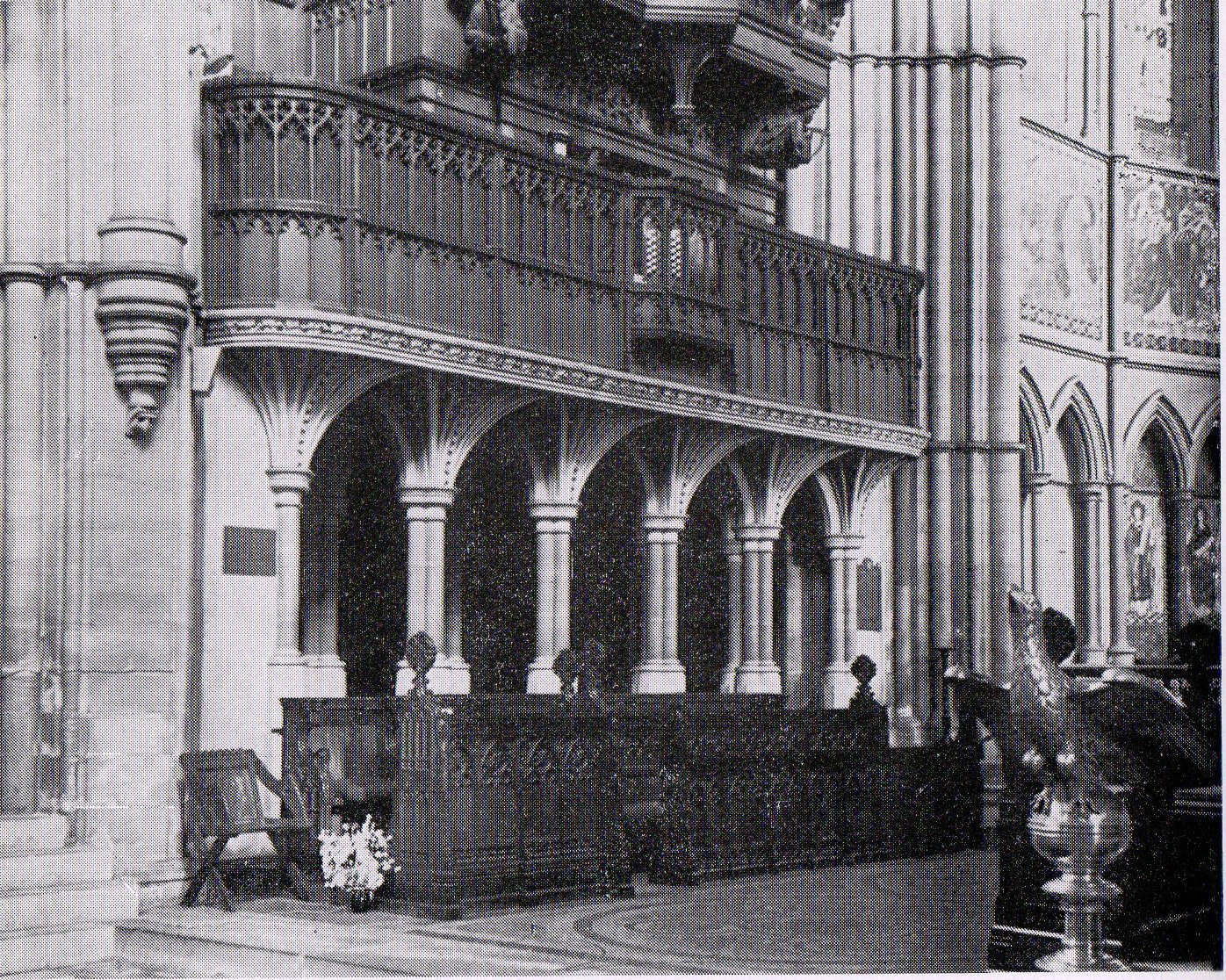
|
|
Left
- Detail of the vaulted stone gallery and walnut screen
To
give the organ ample speaking room, the whole north transept
was used and, to economise in floor space, the handsome gallery
designed by Walker and Athron was built by Frankland & Son
of Armley. It carries the organ 12 feet above the floor
level of the transept and is supported by a double arcade of
clustered shafts carrying a stone vault . A panelled and
traceried screen of walnut runs the whole length of the gallery
between the great piers of the crossing, enclosing the lower
panelled portion of the case and the console.
|
The
speaking pipes in the case are those of the Pedal Metal
Principal Bass 16ft. (now called "Open Metal"), of
zinc with polished tin mouths. The central tower, with the
three largest pipes, projects boldly from the main front and is
surmounted, high under the apex of the great arch of the
crossing, by an angel with trumpet. Surprisingly, the largest
pipe is non-speaking, being flanked by the CCC and CCC sharp
pipes. Indeed many of the larger pipes are not
functional, including several in the side towers. On each
side of the central tower are two tiers of small flats with
non-speaking pipes and beyond these are corner towers, each of
three large pipes, slightly recessed behind the main front and
crowned by winged angels with musical instruments. The
boldly overhanging wings of the case carry flats of five pipes
on both their fronts.
|
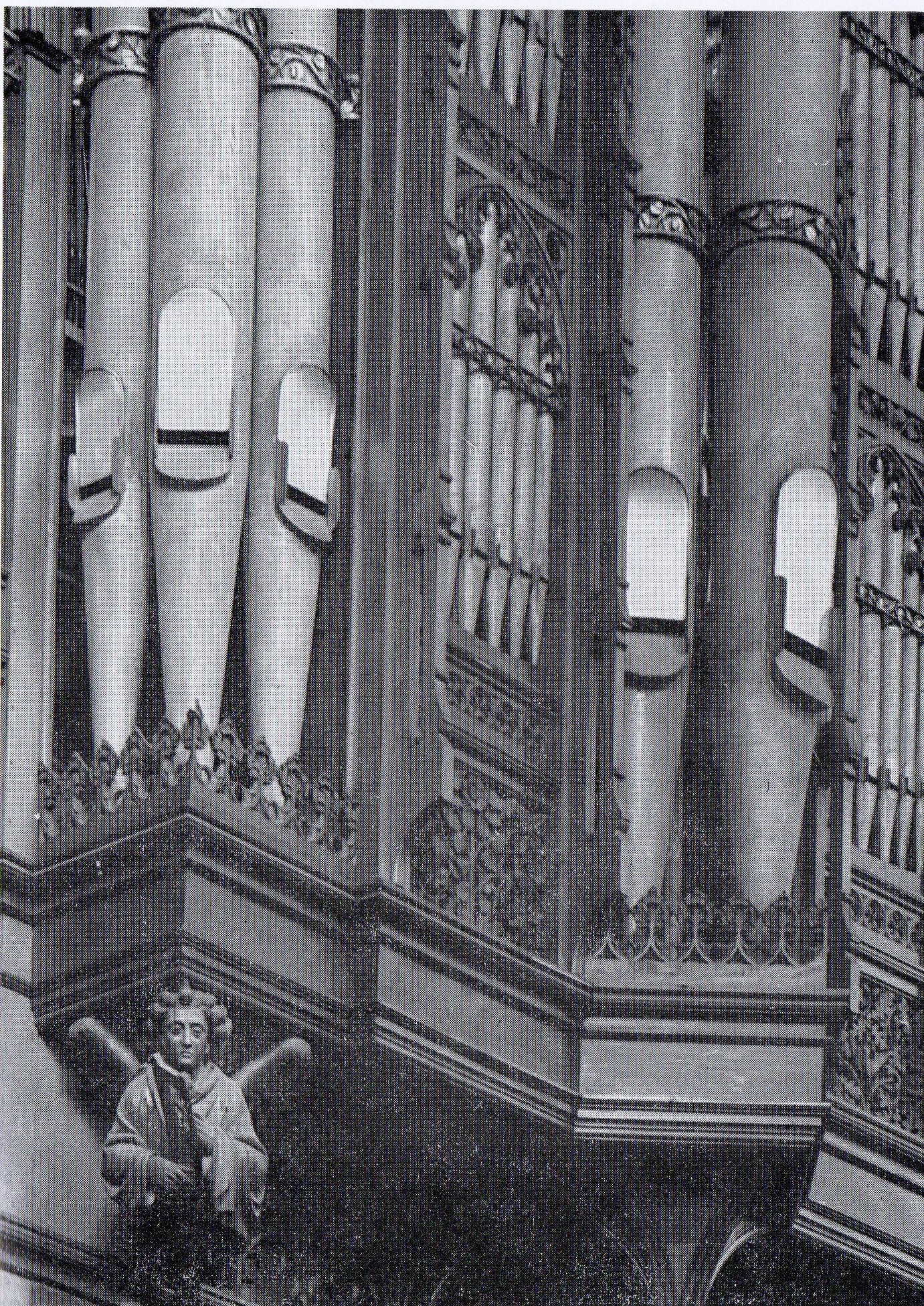
|
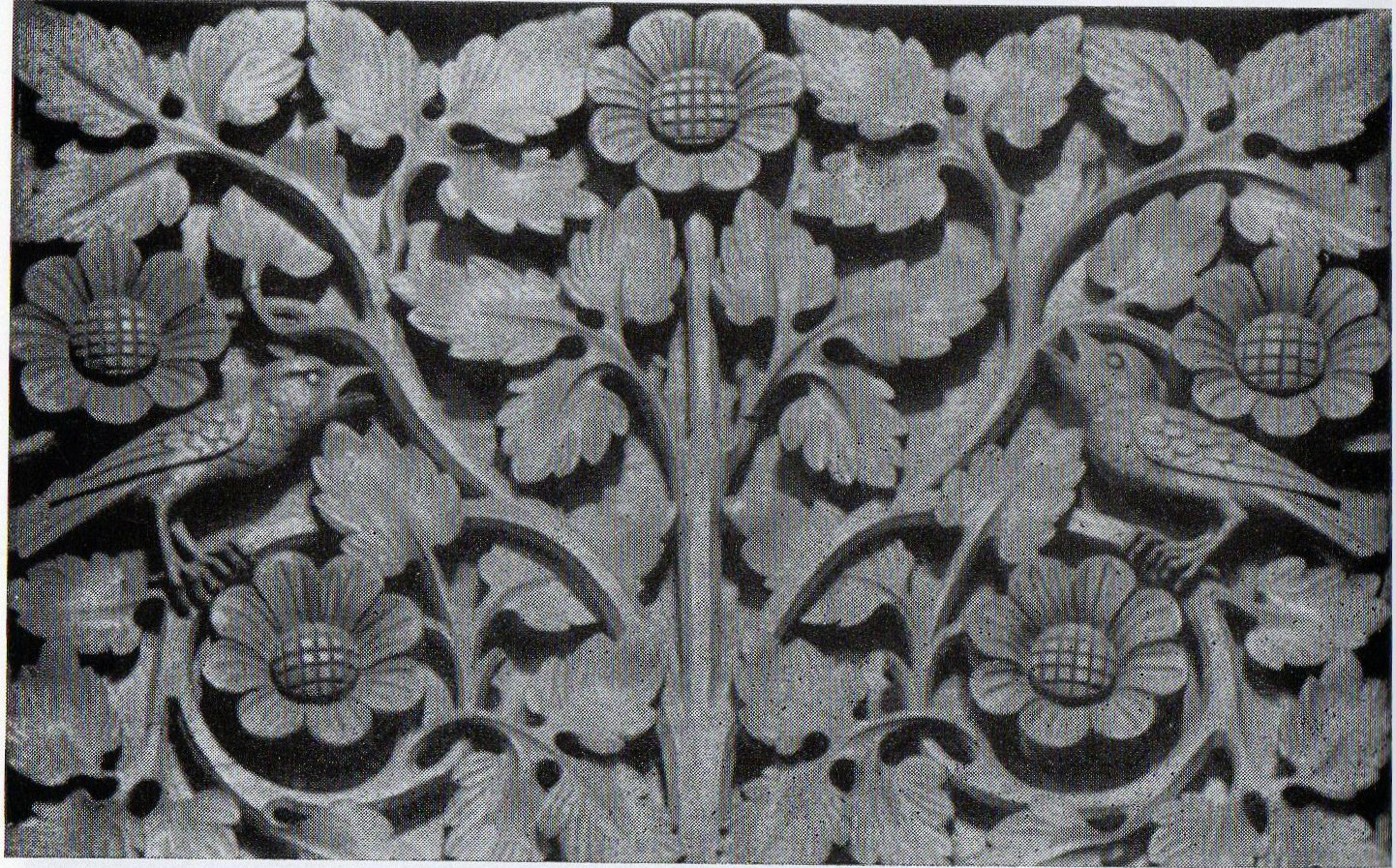
Towers
and flats are richly embellished with pipe shades of Gothic
tracery, whilst carved panels of birds and foliage below the
small flats greatly enrich the case. (above
and below).
|
Brass
bands with flowing foliage designs partly encircle the pipes of
the towers - at two levels on the central tower and at a single
level on the corner towers. Similar bands cross the flats
of pipes and the appearance of the case would probably have
been improved if this metalwork had been omitted. It was
possibly due to the influence of Scott, who frequently
introduced such material during his restoration of Gothic
churches.
The
attached console is placed below the bold pendant of the
central tower of pipes, whilst angels bearing harps spread
their wings below the corner towers.
|
|
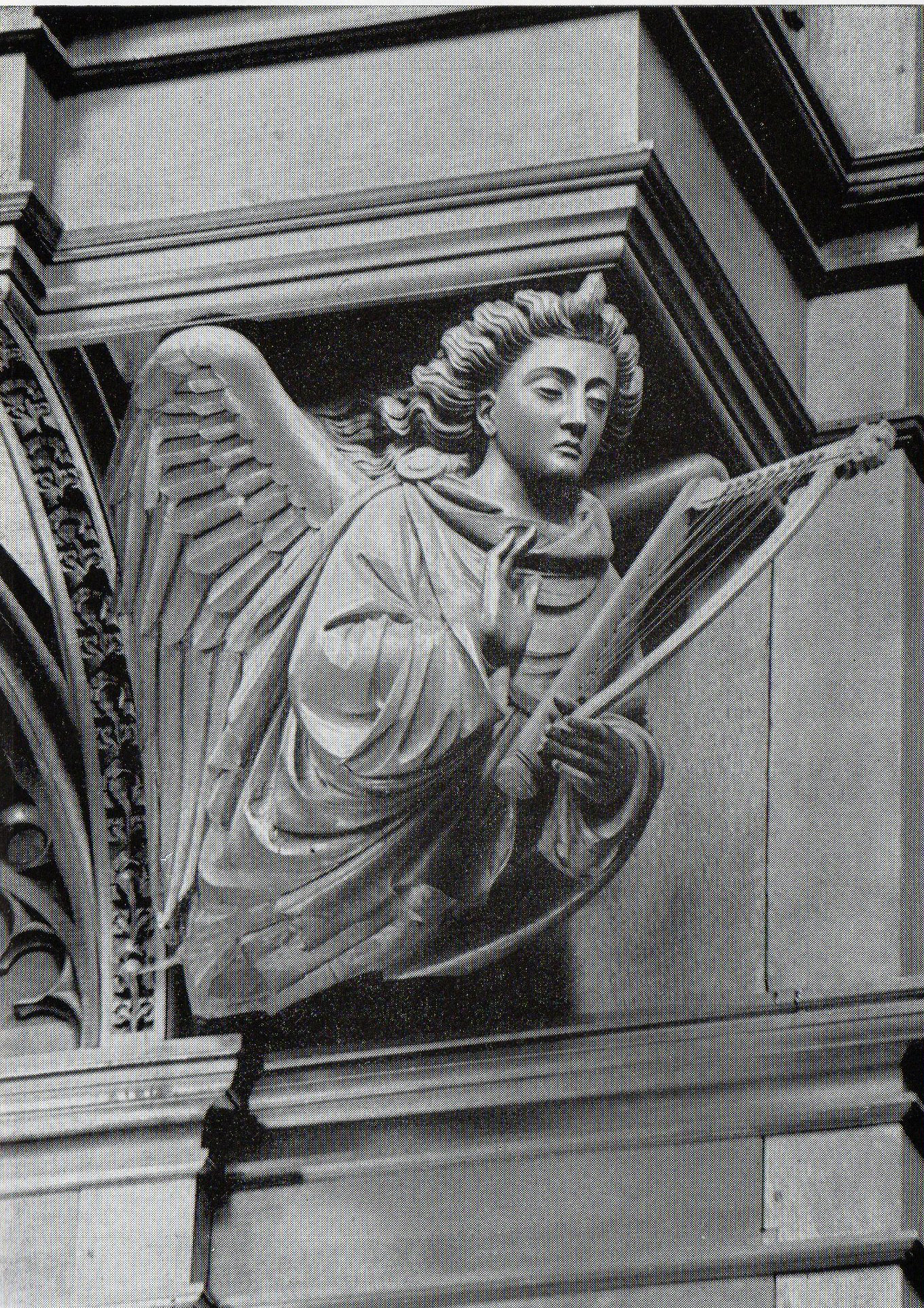
|
|
|
Both
case and walnut screen were made and carved by William Pearson
of Leeds. A panelled screen with tracery above and flats
of small non-speaking pipes closes the small arch opening into
the north aisle of the nave. The case and gallery are
cleverly placed to give an effect of great magnificence when
viewed from the nave, but without obtruding on the view of the
sanctuary.
A
blowing chamber was built outside the north wall of the north
transept, in keeping with the architecture of the church, to
house the hydraulic engines, gas engine, feeders and main
reservoir. The whole expense of this work was borne by Mr.
Eyres, which, including the cost of a lawsuit between a firm of
organ-builders and Mr. R. S. Burton, musical adviser to Mr.
Eyres, amounted to more than £6,000.
The
organ which the Schulze instrument replaced in 1879 formerly
stood in the old church. It was sold to Mr. Eyres who presented
it to Christ Church, Upper Armley, in the same year.
|
Unfortunately,
Mr. Eyres was not destined to hear the glorious tones of the organ
in its new and perfect setting for long. He died during his
wedding tour aged 23, on 6th April, 1881, at Naples, a victim of
typhoid fever, and was buried on 5th May, 1881, in the Eyres
family vault in the Old Church at Armley, following a moving
service in the great new church close by, which was attended by a
large congregation. His gifts to the church were always made
in a quiet and unostentatious way - indeed he would not allow any
plate or inscription to be placed on the organ case to record his
generosity. In 1884 his widow presented the mosaic panels above
the font and below the western lancets as a memorial to her
husband, thus carrying out the wishes of the architects that
mosaic panels should take precedence over the insertion of painted
glass in the windows.
The
erection of the organ on the gallery was carried out by Messrs.
Brindley & Foster, then organ-builders of Sheffield, who as
described in chapter IV were responsible for the erection of the
second Schulze instrument at St. Peter's Church, Harrogate.
Evidence for this was obtained from two sources in 1956, during
the renovation of the organ by Messrs. Hill & Son and Norman &
Beard. In taking out the old hand-blowing apparatus at the
foot of the stairway to the organ gallery, the organist (Mr. J. J.
F. Watkins) found a label attached to a cupboard with the name
"Brindley & Foster" and on the reverse the address
of St. Bartholomew's Church.

|
|
Also
during the 1956 renovation, Mr. Gerald Daines, one of the
organ-builders, discovered five names and the date 1879 carved
on the capital of an attached shaft which carries one of the
wall posts of the roof, about 40ft. above floor level in the
north-east corner of the organ chamber. The names are W.
Powell, C. H. Rawson, A. Lisle, Cook and Schulze. These were
clearly shown on a photograph taken and published by "The
Yorkshire Post." A lady in York identified two of
the names, one as that of her grandfather who worked for
Brindley & Foster, and who often spoke of Schulze; the
second name as one frequently mentioned by her grandfather. The
name "Schulze" probably refers to Eduard Schulze,
younger brother of Edmund, who completed the order for the two
additional Pedal stops added at that time, after the death of
Edmund.
|
During
the erection of the organ at Armley an extraordinary blunder
occurred. The English workman entrusted with the insertion
of the Sub Bass 32ft. stop overlooked the top FF pipe and placed
the feet of the remaining 29 pipes each in a hole too high.
Finding that each pipe was flat, he cut down the pipes in turn by
a semitone until, on reaching the bottom note he found no pipe
available! The man then had a 16ft. stopped
pipe made, which he inserted into the CCCC hole
and which remained until J. J. Binns rebuilt the organ in 1905,
when he supplied a 32ft. open pipe in its place. Mr. T. Cawthra,
on relating this story to the Rev. J. H. Burn, placed the mislaid
pipe in his hands which still remains in the organ next to the
cut-down pipe now sounding top FF, from which it differs by having
the original chamfered top edges.
The
Opening of the Organ at Armley
The
inauguration of the organ was arranged to coincide with the
Dedication Festival of the church. On Saturday, 23rd August, 1879,
the eve of the Feast of St. Bartholomew, choral evensong was sung
by members of the choirs of Leeds Parish Church and of St.
Bartholomew's, augmented by male and female voices, whilst Mr. R.
S. Burton, organist of Leeds Parish Church, once again presided at
the organ. The canticles were sung to Berthold Tours in F, the
anthems being "Sing to the Lord a new song"
(Mendelssohn) and "Hallelujah to the Father"
(Beethoven), the latter apparently being taken so fast that the
words were indistinguishable!
Following
the service, Mr. Burton gave a short recital, including the
Larghetto from a Mozart pianoforte concerto and the War March of
the Priests from Mendelssohn's "Athalie." The splendid
tones of the organ wedded to the magnificent acoustics of the
church were then displayed to the people of Armley for the first
time, although the instrument was not yet complete and still
lacked the new case. At evensong on Sunday, 24th August, St.
Bartholomew's day, the anthem sung was "O Jerusalem"
(Bexfield), the tenor soloist being Mr. Harrison with Mr. W.
Grice, principal Bass of Durham Cathedral who was born in Armley,
as bass soloist. At the close of the service Mr. T. Cawthra,
organist of the church since 1878, played as voluntaries
arrangements of "Zadok the Priest" and the Overture from
"Athalia," both by Handel. It is interesting to note the
preponderance of orchestral and choral arrangements played on the
organ as voluntaries or even as recital pieces at that period, to
the exclusion of legitimate organ music.
It
had been planned to have a series of recitals during the following
week, commencing with Mr. W. T. Best, premier recitalist of the
day, from St. George’s Hall, Liverpool, on Monday, 25th
August, 1879, at 7 p.m. and on Tuesday at 3 p.m., followed by
recitals by Mr. W. Rea of Newcastle-upon-Tyne and Mr. G. Riseley
of Bristol.29 However, when Best arrived at the church to inspect
the organ, he found that the instrument was not complete and
decided that it was unfair to be required to play the advertised
programme under such conditions and left the church. The Vicar,
Canon F. G. Hume-Smith, faced with this emergency and a large and
expectant audience, called on Thomas Cawthra, the organist of the
church, who not only "opened" the organ to the entire
satisfaction of the assembly, but actually played the programme
advertised in the Press. The change of recitalist was not known,
even to Mrs. Cawthra who was present, until an announcement was
made after the recital!

|
|
Mr.
Best, having returned to Leeds, wrote the following letter
which was published in both "The Yorkshire Post and Leeds
Intelligencer" and "Leeds Mercury" on the
following day:
“Sir,
As
I am informed that no reason was assigned by the vicar this
evening at the church of St. Bartholomew, Armley, why I did not
officiate at the advertised organ recital. I feel it due to the
numerous congregation assembled there to state that, on account
of the very incomplete condition of the instrument, it was
impossible for me to play the music selected, the programme for
which was published in your issue of this morning; nor will it
be possible for me to play tomorrow, as announced. I am, etc.
W.T.Best
Queen’s
Hotel, Leeds, August 25th”
Announcements
in both newspapers on the 26th August cancelled the recitals
which were to have taken place during that week. However,
in the following spring recitals were given by Mr. W. Rea (1st
April, 1880) and by Mr. W. T. Best (6th April and 7th April),
the programme of that on the 6th April being, with minor
changes, identical with that arranged for 25th August, 1879.
|
By
Friday, 29th August, 1879, the organ was musically complete,
although still lacking the case and some of the pipes in
prospect. The choirs of Leeds Parish Church and St.
Bartholomew's Church, with additional male and female voices,
combined to give a memorable rendering of 33 numbers from Haydn's
"Creation," a portion of "A Hymn of Praise"
(Mendelssohn), "I know that my Redeemer liveth" and
"Hallelujah" from "Messiah" (Handel).
The tone of the organ, again in the hands of Mr. R. S. Burton,
received high praise and it was evident that the events at
Harrogate, which led to the removal of the organ from St. Peter's
Church, had saved the instrument from probable tonal modification
to accommodate it to the unfavourable acoustics of that church,
and the generosity of Mr. Eyres had placed the instrument in a
noble building with ideal acoustics for organ tone.
|
|
|

